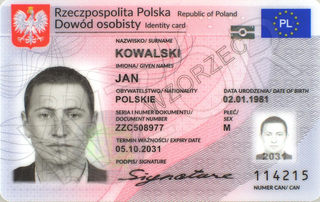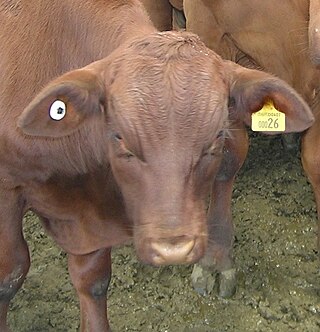An identity document is any document that may be used to prove a person's identity. If issued in a small, standard credit card size form, it is usually called an identity card, or passport card. Some countries issue formal identity documents, as national identification cards that may be compulsory or non-compulsory, while others may require identity verification using regional identification or informal documents. When the identity document incorporates a person's photograph, it may be called photo ID.
A national identification number, national identity number, or national insurance number or JMBG/EMBG is used by the governments of many countries as a means of tracking their citizens, permanent residents, and temporary residents for the purposes of work, taxation, government benefits, health care, and other governmentally-related functions.

The Rural Payments Agency (RPA) is an executive agency of the UK Department for Environment, Food and Rural Affairs (Defra). Prior to Brexit, the RPA delivered the European Union (EU) Common Agricultural Policy (CAP) payments to farmers and traders in England, paying out over £2 billion in subsidies each year. The Agency managing more than 40 schemes, the largest of which the Basic Payment Scheme (BPS) paying more than £1.5 billion to around 105,000 claimants a year.
The Malaysian identity card is the compulsory identity card for Malaysian citizens aged 12 and above. The current identity card, known as MyKad, was introduced by the National Registration Department of Malaysia on 5 September 2001 as one of four MSC Malaysia flagship applications and a replacement for the High Quality Identity Card, Malaysia became the first country in the world to use an identification card that incorporates both photo identification and fingerprint biometric data on an in-built computer chip embedded in a piece of plastic. The main purpose of the card as a validation tool and proof of citizenship other than the birth certificate, MyKad may also serve as a valid driver's license, an ATM card, an electronic purse, and a public key, among other applications, as part of the Malaysian Government Multipurpose Card (GMPC) initiative, if the bearer chooses to activate the functions.
The National Insurance number is a number used in the United Kingdom in the administration of the National Insurance or social security system. It is also used for some purposes in the UK tax system.

A Belgian identity card is a national identity card issued to all citizens of Belgium aged 12 years old and above.

An ear tag is a plastic or metal object used for identification of domestic livestock and other animals. If the ear tag uses Radio Frequency Identification Device (RFID) technology it is referred to as an electronic ear tag. Electronic ear tags conform to international standards ISO 11784 and ISO 11785 working at 134.2 kHz, as well as ISO/IEC 18000-6C operating in the UHF spectrum. There are other non-standard systems such as Destron working at 125 kHz. Although there are many shapes of ear tags, the main types in current use are as follows:
The National Animal Identification System, (naisG) is a government-run program in the United States intended to extend government animal health surveillance by identifying and tracking specific animals. Administered at the federal level by the Animal and Plant Health Inspection Service, a branch of the United States Department of Agriculture, NAIS will also be overseen by state animal health boards. While the federal program is voluntary, money received by some states, tribes, and non-profit entities from the USDA through cooperative agreements has been used to make parts or all of the program mandatory.
A machine-readable passport (MRP) is a machine-readable travel document (MRTD) with the data on the identity page encoded in optical character recognition format. Many countries began to issue machine-readable travel documents in the 1980s. Most travel passports worldwide are MRPs. The International Civil Aviation Organization (ICAO) requires all ICAO member states to only issue MRPs as of April 1, 2010, and all non-MRP passports must expire by November 24, 2015.

The Hong Kong identity card is an official identity document issued by the Immigration Department of Hong Kong. According to the Registration of Persons Ordinance, all residents of age 11 or above who are living in Hong Kong for longer than 180 days must, within 30 days of either reaching the age of 11 or arriving in Hong Kong, register for an HKID. HKIDs contain amongst others the name of the bearer in English, and if applicable in Chinese. The HKID does not expire for the duration of residency in Hong Kong.
In the Republic of Korea, a resident registration number (RRN) is a 13-digit number issued to all residents of South Korea regardless of nationality. Similar to national identification numbers in other countries, it is used to identify people in various private transactions such as banking and employment. It was also used extensively for online identification purposes, but after 2013 resident registration number cannot be used for identification unless other laws require processing resident registration numbers. Foreign nationals receive a foreign resident number (외국인등록번호) upon registration with the local immigration office.

The Romanian identity card is an official identity document issued to every Romanian citizen residing in Romania. It is compulsory to obtain the identity card from 14 years of age. Although Romanian citizens residing abroad are exempt from obtaining the identity card, if they intend to establish a temporary residence in Romania, they may then apply for a provisional identity document, which is valid for one year (renewable).
Basic access control (BAC) is a mechanism specified to ensure only authorized parties can wirelessly read personal information from passports with an RFID chip. It uses data such as the passport number, date of birth and expiration date to negotiate a session key. This key can then be used to encrypt the communication between the passport's chip and a reading device. This mechanism is intended to ensure that the owner of a passport can decide who can read the electronic contents of the passport. This mechanism was first introduced into the German passport on 1 November 2005 and is now also used in many other countries.

The Polish Identity Card is a national identity document issued to Polish citizens. As Poland is a European Union member state it is also serves a European Identity card. Every Polish citizen 18 years of age or older residing permanently in Poland is required to have an identity card issued by the local office of civic affairs. Children as well as Polish citizens living permanently abroad are entitled, but not required, to have one. Identity cards are valid for a period of 10 years.
The Icelandic identification number is the Icelandic national identification number. It is widely used to identify individuals and organisations in Iceland.

The National Livestock Identification System (NLIS) is a livestock identification and tracking system used in Australia. It is administered by Integrity Systems Company, which is a wholly owned subsidiary of Meat and Livestock Australia.
The National Identity Card is the identity document in use in Sri Lanka. It is compulsory for all Sri Lankan citizens who are fifteen years of age and older to have their NICs. NICs are issued by the Department for Registration of Persons. The Registration of Persons Act No. 32 of 1968 as amended by Act Nos 28 and 37 of 1971, Act No. 11 of 1981 and Act No. 8 of 2016 legislates the issuance and usage of NICs.

The German Identity Card is issued to German nationals by local registration offices in Germany and diplomatic missions abroad, while it is produced at the Bundesdruckerei in Berlin.

Animal identification using a means of marking is a process done to identify and track specific animals. It is done for a variety of reasons including verification of ownership, biosecurity control, and tracking for research or agricultural purposes.
The Lebanese identity card is a compulsory Identity document issued to citizens of the Republic of Lebanon by the police on behalf of the Lebanese Ministry of Interior or in Lebanese embassies/consulates (abroad) free of charge. It is proof of identity, citizenship and residence of the Lebanese citizens.











